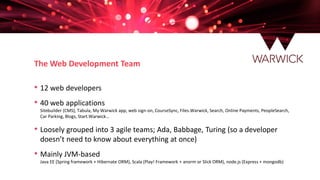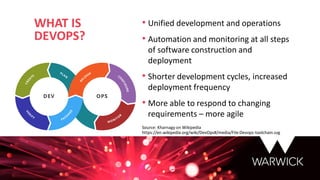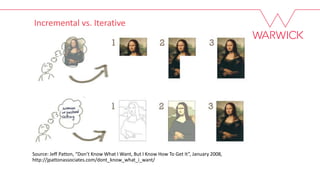Ad
DevOps: Automate all the things
- 1. DEVOPS: AUTOMATE ALL THE THINGS Mat Mannion, Web Development Team Leader, IT Services 14th November 2017 / CS352 Project Management for Computer Scientists
- 2. • 13 years ago I was sat where you are now. I knew nothing, and I didn’t know that I knew nothing. • 6 years as team leader. Many projects come and go. • Everything you do is a learning experience. Why should you listen to me?
- 3. • 12 web developers • 40 web applications Sitebuilder (CMS), Tabula, My Warwick app, web sign-on, CourseSync, Files.Warwick, Search, Online Payments, PeopleSearch, Car Parking, Blogs, Start.Warwick… • Loosely grouped into 3 agile teams; Ada, Babbage, Turing (so a developer doesn’t need to know about everything at once) • Mainly JVM-based Java EE (Spring framework + Hibernate ORM), Scala (Play! Framework + anorm or Slick ORM), node.js (Express + mongodb) The Web Development Team
- 4. • Unified development and operations • Automation and monitoring at all steps of software construction and deployment • Shorter development cycles, increased deployment frequency • More able to respond to changing requirements – more agile WHAT IS DEVOPS? Source: Kharnagy on Wikipedia https://en.wikipedia.org/wiki/DevOps#/media/File:Devops-toolchain.svg
- 5. PLAN
- 6. • Initial questions: - Who’s paying for it? - Who’s going to use it? - Is there a requirements document? - Do we buy or build? • In the 21st Century, software evolves • So is this a product, or is it a service? BRIEF: REPLACE THE EXISTING TOOL TO PROVIDE ID PHOTOS
- 7. “A project has a finite and defined lifespan” PRINCE2:
- 8. • Agile software development • Rapid, continuous delivery of useful software • Late breaking changes are welcome (mostly) • Close co-operation between stakeholders and the software development team Build, but build how?
- 9. Incremental vs. Iterative Source: Jeff Patton, “Don’t Know What I Want, But I Know How To Get It”, January 2008, http://jpattonassociates.com/dont_know_what_i_want/
- 10. • Work is taken from the backlog at the start of a sprint in a sprint planning meeting • Daily stand-ups to assess progress and work through any blockers • Sprint review meeting and release at the end of the sprint, if approved by the product owner Scrum or Kanban? With Scrum, build in a series of fixed-length iterations, with milestones at the end of each sprint • Work travels from left to right on a Kanban board through defined stages from the backlog to completion • Releases can happen continuously, or at the team’s discretion • Change can happen at any time With Kanban, build to just in time (JIT) principles with continuous deployment
- 11. • Meetings at the end of sprints to review the previous sprint and plan the next one • Daily stand-ups to keep the team focused on the sprint goals • Release at the end of sprints with work packages – each sprint has a goal Scrumban! Take some of the structure from Scrum that helps visibility to stakeholders: • Within a sprint, work travels across a Kanban board • Changes can happen to the work during the sprint (but are generally discouraged as we can’t learn about velocity of the team) Take some of the flexibility of Kanban:
- 12. • Bring together the development team with product owner • Identify development themes • Split themes into epics (big user stories) • Break down epics into stories – a story should fit within a single sprint (if it doesn’t, break it down further) • Stories may comprise multiple tasks • “Definition of Done” – consistent acceptance criteria across all user stories Initial planning meeting Photo upload As a new student, I need to provide an official photo As a new student, I want to upload a new official photo Create photo upload form Send uploaded photo to membership system As a new student, I want to be able to change my official photo Create page to display all uploaded photos Set photo in membership when selected Theme Epic Story Task
- 13. • Estimating is hard • Defining how many hours a task will take at the start of the project is near-impossible • Just give rough estimates to start with • We use t-shirt sizes, i.e. XS, S, M, L, XL, XXL, XXXL • Anything over L probably isn’t doable in a single sprint • We can get better at estimating as we gain experience in the project How long is a piece of string?
- 14. The cone of uncertainty Source: Steve McConnel, The Cone of Uncertainty http://www.construx.com/Thought_Leadership/Books/The_Cone_of_Uncertainty/
- 15. • Do MoSCoW prioritisation of stories from the backlog – do this every time as priorities change • Take the highest priority stories and put them into the next sprint • Only put as much in there as you can achieve – as estimations get better, this will become more accurate • Anything not done at the end of each sprint goes back into the backlog for re-prioritisation Sprint planning meeting Source: https://www.agilebusiness.org/content/moscow-prioritisation-0
- 16. CREATE
- 18. Kanban board
- 19. Development practices that support iterative development • Pair programming on new features and changes – effectively constant code review • Continuous integration (using Bamboo, in our case) to ensure that the system meets all automated testing (“Definition of Done”) • Coding standards to define a consistent style and format • Code reviews for all non-trivial changes before they are merged into the mainline There are a number of development practices that we use to make agile development work well and produce good quality, maintainable software. We use many practices from Extreme Programming (XP):
- 20. • A branching model for a git (or other VCS) repository • Development is against a develop branch, master is always the current state of production • Work takes place in branches off develop – branches are named after issue numbers. Keep feature branches relatively short-lived so they don’t diverge • When it’s time to release, this is branched off as a release branch (e.g. release/1.0) to allow work to continue on develop • Code reviews whenever we want to merge into develop or master Git flow Source: http://nvie.com/posts/a-successful-git-branching-model/
- 21. • Demo what’s changed in the most recent sprint to the customers • Take feedback for the next sprint • If everyone agrees, release the work to production • Make a cup of tea and start again, using the gained knowledge to improve prioritisation and estimation Sprint review meeting
- 23. Issue tracking
- 25. Code review
- 26. Code review
- 27. Look back – what was the discussion?
- 28. Deploy
- 29. CONFIGURE
- 30. • Architecture and team must support continuous delivery • Traditionally servers are the responsibility of an Ops or Platforms team – who probably don’t understand the software you’re deploying on it • In our environment, Operations manage the tin, then jointly configure and manage servers through code BRIEF: NOW YOU’VE BUILT IT, RUN IT FOREVER
- 31. • Bad: Run an application server (e.g.) Tomcat, deploy the application to it. Redeploys unload the application and reload it • Less bad: Run a web server (e.g. Apache) and load balance (mod_jk or HAproxy) across multiple application servers. Redeploys can take servers out of the load balancing pool to minimise downtime. Still a SPOF • Good: Load balance across multiple servers with a load balancer appliance. Separate concerns by running a service-oriented architecture for database, storage, search etc. • Very good: Deploy your application as containers (e.g. Docker). Build new containers in CI and switch out an entire new set of containers when deploying new versions Application architecture - evolution We are here
- 32. • Have to design your applications to run in a stateless environment • No local filesystem, no in-memory or filesystem sessions • Build your applications so it doesn’t matter if you hit one server with your first request and a different one with your second • Build mechanisms for your applications to communicate with each other where necessary (e.g. propagating configuration changes while running) Building stateless applications
- 33. • ~40 applications, dev, test & prod, separation of concerns. >750 nodes (at time of writing) • How do you maintain configuration and consistency? • How does support and maintenance work for applications co-located across many servers? • Our solution: Configure with code, decentralise all management, have the system describe itself The problem:
- 35. • A node tuac3-tabula-prod-api-1 describes itself as running on the physical server tuac3, part of the tabula application, the production deployment, the api tier • The node sends facts about itself to the master; e.g. that it’s running Solaris 11.2 Node classification, roles and profiles Each node describes what it is, and that builds a classification along with facts about the node: • Profiles to manage SSL, Java, Tomcat • Our YAML configuration files describe configuration specific to applications, deployments, tiers etc. which are combined to get the actual configuration • PuppetDB stores information about all configured nodes and can be queried to create overarching config A number of profiles are applied to nodes based on its classification:
- 36. • 24 nodes in each Tabula deployment across 2 data centres • 4 application nodes • 4 API nodes • 4 background task processors • 4 message queue brokers • 4 memcache nodes • 3-node ElasticSearch cluster + 1 Kibana node • Multiply out for dev, test, sandbox (training) deployments What does it look like in practice? • F5 BIG-IP load balancer • Object storage service for storing files (OpenStack Swift) • Oracle RAC cluster for database
- 37. MONITOR
- 38. • check_mk monitors general health of the node (memory/CPU etc) • This runs as a script on the node itself and the result is collected by central monitoring server(s) • Deliver check_mk plugins for each profile applied to a node (e.g. Tomcat or memcache) • Each application we deploy delivers service endpoints to monitor the application – gtg, healthcheck, metrics • Keep performance data for a long time to spot trends • Notifications go into Slack channels, email, SMS, depending on the importance of the node (e.g. is it prod, is it a dependency for other apps) Monitoring individual nodes
- 39. • All our logs (application, audit and access) are sent and stored securely on an ELK centralised logging service • We monitor patterns in logs and alert on an exception basis (e.g. increased error rates, increased avg response times etc.) • We can visualise log data across multiple instances of an application or even multiple applications to diagnose issues Monitoring applications
- 40. ANY QUESTIONS? • https://www.atlassian.com/agile/kanban • https://aws.amazon.com/devops/what-is-devops/ • http://nvie.com/posts/a-successful-git-branching-model/ Resources / further reading




























































![Java script nirvana in netbeans [con5679]](https://cdn.slidesharecdn.com/ss_thumbnails/javascriptnirvanainnetbeanscon5679-160927041807-thumbnail.jpg?width=560&fit=bounds)






































![Download Wondershare Filmora Crack [2025] With Latest](https://cdn.slidesharecdn.com/ss_thumbnails/neo4j-howkgsareshapingthefutureofgenerativeaiatawssummitlondonapril2024-240426125209-2d9db05d-250419-250428115407-a04afffa-thumbnail.jpg?width=560&fit=bounds)








